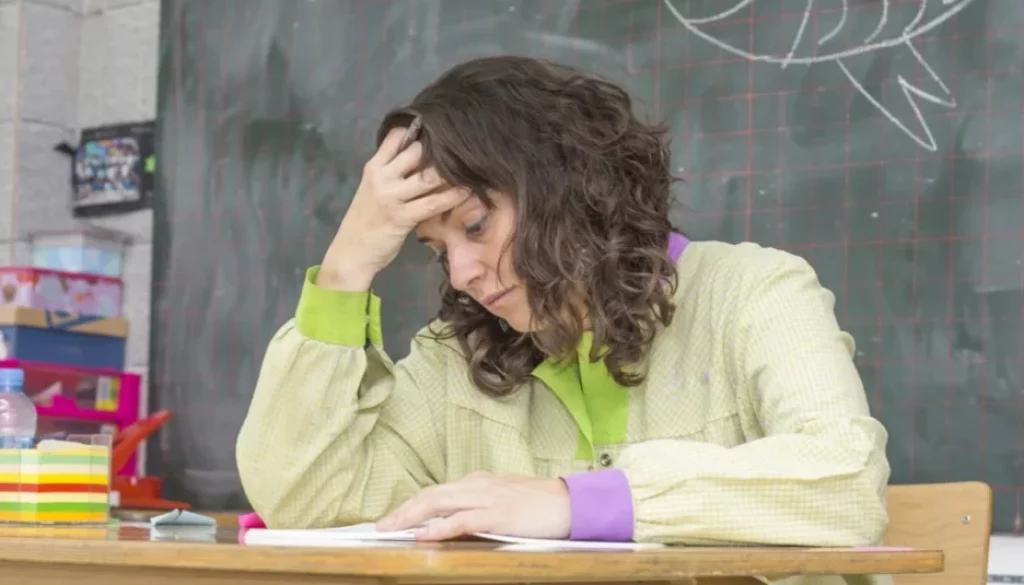La violence à l’encontre des enseignants est une crise nationale silencieuse
There is very limited research into violence against teachers, and what research has been done often contradicts official statistics. This would imply incidences of violence against teachers are not being reported and therefore resources are not being made available to address the problem.
Violence against teachers is a national crisis that cost teachers, parents, and taxpayers $2 billion annually. In 2011, the American Psychological Association (APA) conducted one of the few national studies on violence against teachers. Almost three thousand teachers responded to an anonymous online survey asking about their “victimization experiences”, and 80% of those who responded claimed to have had one or more victimization experience in the previous twelve months.
Each year the National Center for Education Statistics produces a report called “Indicators of School Crime and Safety”. For 2011, the report stated 9.2% of teachers had been threatened with violence, and 5.4% of teachers had actually been physically attacked.
There are several possible explanations for the discrepancy between the APA study and the School Crime and Safety Report. For example, in the APA study, victimization was defined as any violent incident including disrespectful behavior, verbal threats or property damage. The School Crime and Safety Report only featured reported threats and assaults.
However, the key word here is “reported”. While almost three thousand teachers may have been willing to share their experiences anonymously, many teachers are dissuaded from filing official reports as they will count against the school’s DESE rating. Dr. Dorothy Espelage of the University of Chicago of Illinois at Urbana-Champaign, chair of the APA Task Force on Violence Directed at Teachers, sat down with NEA Today to discuss the findings of the survey and to provide recommendations on how to ensure teacher victimization becomes a component of any comprehensive school safety plan.
Survey Results: How Bad is Violence against Teachers?
3,000 K-12 teachers from 48 states responded to an anonymous web-based survey to detail their victimization experiences during the current or past year.
- 80% of teachers reported at least one victimization experience in the current or past year, and of those who experienced an offense, 94% reported being victimized by students
- Nearly half of victimized teachers reported that they had experienced offenses by two or more different types of perpetrators (e.g. students and parents)
- 72.5% of teachers reported having experienced at least harassment offense (e.g. obscene gestures, verbal threats and intimidation, and obscene remarks)
- 50% of teachers experienced property offenses (e.g. theft or damage to property)
- 44% of teachers reported being physically attacked
- The nationwide costs of teacher victimization to teachers, parents, and taxpayers exceed $2 billion annually
It’s difficult to determine the true extent of these violent incidents. Although the APA study was the largest of its kind, the three thousand teachers who responded out of a teaching population of three and a half million is a fairly small sample. Based on studies conducted by various teaching associations – and those conducted in other countries – the percentage of teachers being attacked in schools is closer to the 80% figure reported in the APA study, rather than the 5.4% reported in the School Crime and Safety Report.
In Israel, for example, a nationwide survey revealed that 73% of teachers had suffered a victimization experience in 2017 using the APA’s criteria of teachers being attacked in schools. The 8% year-on-year escalation prompted the state’s legislators to introduce an amendment to the penal code that will increase the punishment for violence against teachers to five years imprisonment.
Argentina had a similar problem with increasing violence against teachers until the country passed a law classifying any attack on a teacher as aggravated assault. Students and parents found guilty of violence against teachers will now be subject to 25% longer jail sentences or 25% larger fines than if a similar offense had been committed against anybody else.
Attempts to introduce similar laws in the US have been criticized for creating a fast-track from school to prison – particularly as they would most likely hurt students with special needs who are already statistically at a much higher risk of incarceration. Critics want more resources invested to address the root cause of the problem – which is difficult when the scale of the problem is hard to quantify.
The Hidden Cost of Teacher Victimization
Violence against teachers is a significant yet under-investigated problem in the United States that has profound implications for schooling, teacher retention, and overall student performance. Teachers report feelings of anxiety and depression were related to lower professional functioning, decreased productiveness in the classroom, and lower emotional or physical well-being. As teachers become unable to perform in the classroom, student engagement and academic achievement are negatively affected. Below are some of the hidden costs associated with teacher victimization:
- Lost wages on the part of victims
- Increased workman’s compensation payments due to acute psychological distress
- Emotional and physical trauma
- Greater substitute teachers
- Lost instructional time and productivity
Violence against teachers and the consequences that follow negatively impact teacher recruitment and retention by discouraging potential educators from entering the field of education. Lack of knowledge on teacher victimization has left many schools unable to provide the support networked necessary for the teacher, and ultimately student, success.
Solutions to Prevent Teachers being Attacked in Schools
As violence against teachers is under-reported, not enough resources are being directed into researching the reasons for teachers being attacked in schools. What is known is that it is not only a student vs. teacher problem. Teachers are frequently assaulted by parents (37% according to the APA study) and colleagues (21%).
Various solutions have been suggested, from establishing a national registry of incidents of violence directed against teachers so that more research can be conducted, to teaching preventative methods and intervention strategies during pre-service training to better prepare teachers for when they are the subject of violent attacks in schools.
Unfortunately, both of these solutions take time to deliver positive outcomes. More research may help understand the root cause of the problem, but by the time measures are implemented to address the root cause, many more teachers will be hurt in avoidable attacks. Similarly, pre-service training will not be of any benefit to those already employed in teaching.
Furthermore, violence against teachers and the consequences that follow negatively impact teacher recruitment and retention by discouraging potential educators from entering the field of education. Lack of knowledge on teacher victimization has left many schools unable to provide the support networked necessary for the teacher, and ultimately student, success.
Action Schools Can Take Now to Protect Teachers
Schools do not have to wait until more focus is placed on violence against teachers before taking action to protect their staff. Safety solutions exist that enable teachers to quickly communicate with on-site security and 911 when a situation is escalating and likely to conclude with violence. These safety solutions have multiple benefits in addition to preventing teachers being attacked in schools.
- There is a record of each time the solution is used to accurately compile data about teachers being attacked in schools.
- The solutions can be used to summon assistance in the event of school emergencies – such as fires, medical alerts and active shooters.
- Administrators can monitor and manage incidents in real time to coordinate the appropriate response and minimize disruption.
According to Dr. Dorothy Espelage, any comprehensive examination of school violence must include violence directed at teachers. Focusing solely on student victimization and excluding violence against teachers’ results in an inadequate representation of safety issues, which makes it more difficult to formulate effective solutions.
Although the short-term outcome of implementing safety solutions is that reported incidents of violence against teachers will increase, the longer term consequences will be more research into the root cause of violence in schools and more resources dedicated to eradicating it. Ultimately, that will result in a better teaching environment for teachers and pupils alike. Surely that would be a good thing.





